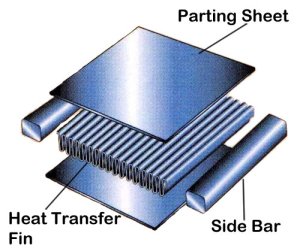A plate-fin heat exchanger is a type of heat exchanger that uses a combination of plates and fins to transfer heat between two fluids. The heat exchanger consists of a series of parallel plates, which are separated by fins. The fins are used to increase the surface area for heat transfer. This increase in surface area results in higher heat exchanger efficiency.
Table of Content:
How do Plate Fin Heat Exchangers Work?
Plate Fin Heat Exchanger Design
Plate Fin Heat Exchanger Applications
How do Plate Fin Heat Exchangers Work?
Parts
First, understand the components of the plate-fin heat exchanger.
Parting sheets or Plates: These are thin metal sheets that divide the plates and fins into separate fluid paths. These plates serve to prevent fluid mixing between the two fluid streams.
Side bars: These are metal bars that run along the sides of the heat exchanger. They provide support and stability to the plates and fins.
Heat Transfer Fins: Thin metal fins attached to the plates, increase the surface area for heat transfer. Fins provide additional surface area for heat transfer between the two fluid streams. This increases the efficiency of the heat exchanger.
The shape and configuration of the fins can be optimized for specific heat transfer requirements. The different designs of fins provide different levels of heat transfer efficiency. The above schematic shows different types of fins used in process industries.
The three most prevalent fin arrangements in plate fin heat exchangers are,
(1) Plain (straight and uninterrupted) fins with rectangular, trapezoidal, or triangular passages.
(2) Uninterrupted wavy fins.
(3) Interrupted fins such as offset strip, louvered, perforated and pin fins.
The fins are typically made of lightweight, high-conductivity metal such as aluminum or copper, and are designed to maximize heat transfer while minimizing fluid resistance.
Working Principle
In principle, these exchangers are similar to plate and frame exchangers. It involves alternating chambers of hot and cold fluids separated by thin metal sheets. The difference is that two metal sheets that form one chamber are separated by wavy, perforated metallic fins which form channels to allow the passage of fluid. Two opposite sides of each chamber are sealed with a sidebar and the other two sides allow the inflow and outflow of fluid. The sealed sides are rotated at 90 degrees for alternating chambers. So the hot and cold fluid flows are always at 90 degrees to each other.
The fluids flow through the heat exchanger in separate channels, which are created by the plates. The fluids can flow in either the same or opposite directions, depending on the design of the heat exchanger. The plates and fins are typically made of materials such as aluminum or copper, which have high thermal conductivity.
Plate Fin Heat Exchanger Design
Overall, the design of a plate fin heat exchanger is an iterative process. It involves optimizing the dimensions and materials of the plates, fins, headers, and other components to provide efficient heat transfer and minimal pressure drop. The design process typically involves the following steps:
- The first step in designing a plate fin heat exchanger is to determine the heat transfer requirements. This involves determining the desired heat transfer rate, the temperature difference between the two fluid streams, and the fluid properties.
- The next step is to determine the fluid paths, either concurrent or counter-current, that will provide the desired heat transfer characteristics.
- The plate and fin dimensions are calculated based on the fluid paths. This involves the calculation of the type of fin to be used, plate thickness, plate spacing, and fin spacing.
- The materials used for the plates, fins, and other components are selected based on the operating conditions, including temperature, pressure, and fluid properties.
- The header and gasket design are optimized to provide proper fluid connections and prevent fluid leakage.
- The design is optimized to minimize pressure drop, which can impact the overall efficiency of the heat exchanger.
- The final design is verified through testing and simulations to ensure that it meets the heat transfer requirements and operates efficiently.
Here you can study heat exchanger design in detail.
Plate Fin Heat Exchanger Applications
- Plate fin heat exchangers are used in the cooling system of vehicles. Fluid is circulated through the exchanger where heat is transferred from the fluid to the metal plates and fins. It transfers heat from the engine coolant to the air. Basically, this helps to keep the engine to operate at the proper temperature.
- In HVAC systems, these exchangers are used to cool and heat air. They are often used as part of air-to-air or air-to-liquid systems to regulate the temperature of the air being circulated. These heat exchangers are preferred for HVAC and refrigeration systems because they are highly efficient, compact, and easy to maintain.
- In refrigeration systems, Plate fin exchangers are used to cool refrigerants. The refrigerants are circulated through it where heat is transferred from the refrigerants to the other fluid by metal plates and fins. The cooled refrigerants then return to the refrigeration system.
- The heat generated during power generation is transferred from the steam or fluid to the metal plates and fins. It reduces the temperature of the fluid and improves its efficiency.
- In the aerospace industry, Plate fin heat exchangers are used to cool avionics and engines. The high thermal efficiency of these exchangers makes them suitable for such applications, where weight and space limitations are critical factors.
Advantages & Disadvantages
Advantages |
Disadvantages |
|
|







